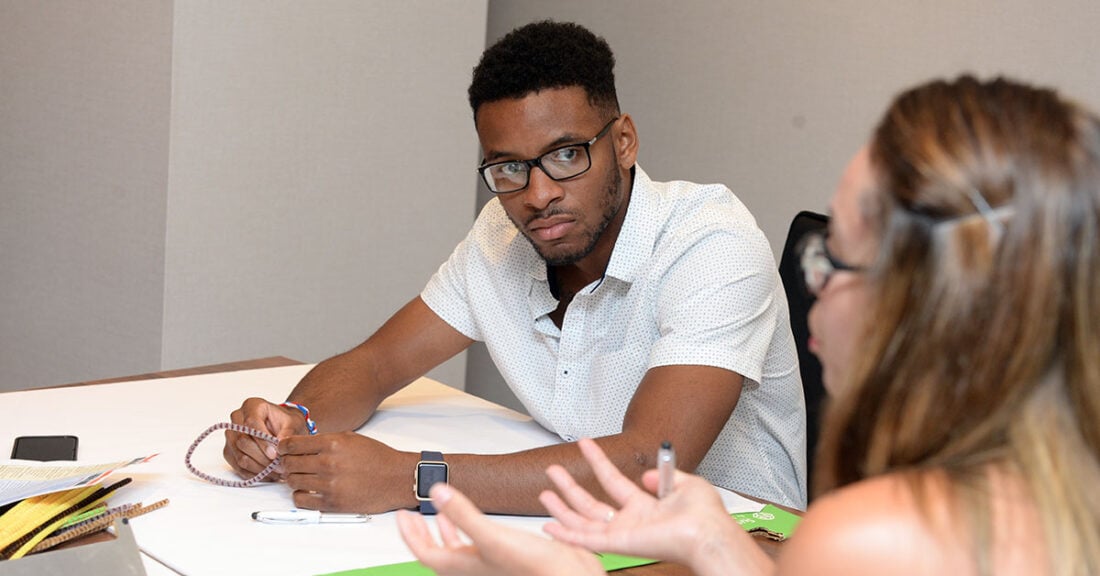Engaging Youth in Foster Care to Build a Brighter Future in Baltimore

Malik Jones, a Jim Casey Young Fellow
When Malik Jones talks with youth in foster care about his college experiences, they listen attentively and ask thoughtful questions — because the Towson University senior grew up in foster care, too.
This interaction is part of a spectrum of activities that resulted from a three-year-old partnership between the Baltimore City Department of Social Services (BCDSS) and the Annie E. Casey Foundation’s Jim Casey Youth Opportunities Initiative®, which works nationally to improve outcomes for young people transitioning from foster care to adulthood.
Jones, a Jim Casey Young Fellow, credits BCDSS for choosing him to speak to the members of the department’s Youth Advisory Board (YAB), which was revitalized as a result of the partnership. He hopes these exchanges inspire the young people to pursue a college degree as they seek better lives. “That’s a smart move,” he says of being selected to speak with them. “It’s different hearing from another youth about college than hearing from an adult.”
Like the young people involved in Baltimore’s advisory board, Jones is committed to improving the foster care system, whether by helping young people understand and cope with systemic racism or learning about the threat of homelessness after leaving foster care. “I don’t want young people to go through what I went through,” he says. “I’ll do whatever I can to help.”
Bringing in trusted role models is one way BCDSS partners with young people in foster care. “Young people with experience in foster care or other systems are vital voices for change — and any effort to improve outcomes for them and their communities necessarily needs to involve them,” says Sandra Gasca-Gonzalez, vice president of Casey’s Center for Systems Innovation. “Young people are poised to make a difference. It’s time all of us pay attention.”
Randi Walters, who was recently named BCDSS director, adds: “What I first noticed when I started meeting with families and staff was the incredible optimism that emanated from our partnership with the Jim Casey Initiative. Staff and young people were engaged with one another and focused on results. That’s exactly the kind of energy we need to drive improvements in the child welfare system and beyond.”
Results of the relationship between young people and Ready by 21, the BCDSS unit charged with helping young people prepare for adulthood, include the YAB and Opportunity Passport®.
Opportunity Passport, which helps young people with experience in foster care learn to manage their money, has three components: financial education, access to mainstream banking and matched savings. BCDSS is a leader nationally in enrolling young people in Opportunity Passport, says Leslie Gross, director of the Jim Casey Initiative. In Baltimore, 158 young people have participated in the program over the last three years, with eight of them purchasing assets worth more than $27,000. Individual savings of $13,600 were doubled through the program’s matched savings.
“It feels good to help provide assets to youth,” says Ready by 21 Program Manager Amesha M. Smith. Purchases go toward housing, transportation and even certificates of deposit. “We know that young people create their own networks, talk to each other and spread the news,” she says. “The Opportunity Passport is good news to spread.”
The Opportunity Passport also is a tool that promotes equity. In a city where black youth have higher rates of entering the child welfare system and are 1.5 times more likely to be in a group placement than living with a family, nine in 10 Opportunity Passport participants are African American.
The YAB, a youth-run group that meets monthly, is open to any young person in foster care and includes dinners, field trips, special events and networking opportunities. It offers a chance for building friendships and more — including giving feedback to BCDSS to improve policies and practices.
“We work with the board differently now,” Smith says. “When we are rolling out something new that will impact young people — a policy, a new life skills class — we first go to the young people and ask for their input. We also find other ways, beyond the YAB, to gather youth input.”
When Smith’s team was working to understand issues facing pregnant and parenting young people, she says, “we brought two young ladies to the table who are current parents. We used several of their ideas, incorporating them into our work.”
This fall, BCDSS is seeking to broaden its collaboration with the Foundation, encouraged by Lourdes Padilla, who as secretary for the Maryland Department of Human Services oversees the state’s 24 social services agencies, including Baltimore’s. The agency’s work with Casey has demonstrated that working with other organizations can benefit kids and families, Padilla says.





